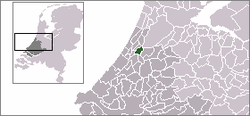Warmond
| Warmond | |||
|---|---|---|---|
| |||
| Coordinates: 52°11′50″N 4°30′6″E / 52.19722°N 4.50167°ECoordinates: 52°11′50″N 4°30′6″E / 52.19722°N 4.50167°E | |||
| Country | Netherlands | ||
| Province | Zuid-Holland | ||
| Municipality | Teylingen | ||
| Population (2005) | 4,915 | ||




Warmond (Dutch pronunciation: [ˈʋɑrmɔnt]) is a village and former municipality in the western Netherlands, north of Leiden in the province of South Holland. The municipality covered an area of 14.42 km² (5.57 mile², 30.7%) of which 4.42 km² (1.71 mile²) is water, and had a population of 4,977 in 2004. Together with Sassenheim and Voorhout, it became part of the Teylingen municipality on 1 January 2006. Warmond is located in an area called the "Dune and Bulb Region" (Duin- en Bollenstreek), and is notable for being extremely affluent.
Warmond is situated on a lake system called Kagerplassen and has several marinas which make it a popular recreational area for boating and other water sports.
An 18th-century mansion called "Huys te Warmond" ("House at Warmond") is located north of the village along the main road.
Demographics (2000)
When it was a municipality, Warmond had the highest death rate in all of Netherlands. (22.3 per 1000 in 2004, three times the national average). Now Laren has the highest Death Rate in all of Netherlands.
Notable inhabitants
The Dutch painter Jan Steen lived in Warmond for a brief period, his house can still be visited. It is also the home of Dutch author Maarten 't Hart who regularly uses the village and its inhabitants as inspiration for his novels. Antonie van Leeuwenhoek, commonly known as "the Father of Microbiology", and considered to be the first microbiologist, was schooled in Warmond.
- The film comedienne Truus van Aalten died in Warmond in 1999.
External links
| Wikimedia Commons has media related to Warmond. |

